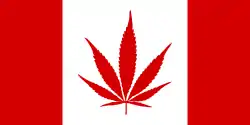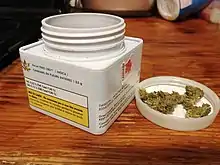Cannabis in Alberta
Cannabis in Alberta became legalized on October 17, 2018 following the coming into force of federal Bill C-45. Production, distribution and consumption of cannabis had been prohibited in Canada since 1923. While some other provinces distribute cannabis through publicly owned retail monopolies, Alberta allows private companies to sell cannabis at licensed retail storefronts. Private retailers must purchase cannabis from the provincial wholesaler, the AGLC. The Alberta government is the sole e-commerce marketplace for cannabis sales within the province.
| Part of series on |
| Cannabis in Canada |
|---|
 |
| National legislation |
| Provincial and territorial regulations |
| Other jurisdictions |
|
Cannabis portal Canada portal |
Legalization for recreational use

The minimum age for recreational use of marijuana is 18 (the same age Albertans can buy or drink alcohol, buy cigarettes and e-cigarettes and gamble) and sales are made at private enterprise stores licensed by Alberta Gaming, Liquor and Cannabis or from the government's web site. Retail stores licensed to sell cannabis must not also sell alcohol, tobacco or pharmaceuticals. The product available includes dried flower, milled flower, plant seeds, oil, capsules and pre-rolls. Edibles, concentrates and topicals became legal to sell in October 2019. The rules as to where cannabis can be consumed vary from city to city, but typically, Albertans can do so in their homes and in some public spaces where cigarette smoking is allowed, but cannabis use is banned in cars. Specific laws about driving under the influence of cannabis are in place.[1]
Canadian Cannabis Chamber
The national Canadian Cannabis Chamber is based in Alberta, and is staffed by Jonathan Denis, the province's former Justice Minister, and Rick Hanson, the former police chief of the province's largest city, Calgary.[2]
Industrial hemp
Hemp production was legalized in 1998 and Alberta grew thousands of acres by the 2000s.[3] In 2011, Alberta grew 6,434 hectares (15,900 acres), about 40% of Canada's hemp and 40% of the nation's hemp seed.[4] Alberta is generally arid and hemp is grown under irrigation.[5] In 2013, the cultivars in use were from Europe, with experiments with new cultivars suited to prairie climate (X59, CFX-2, CRS-1, Silesia, Canada, and Delores) underway at locations in Canada including Alberta.[6] In 2014, the Finola cultivar, a Finnish cultivar accounting for a third of national production,[7] dominated Alberta's production at 7,400 hectares (18,000 acres).[8]
Usage
In 2013, 11.8 percent of residents reported that they consumed cannabis in the past twelve months, the fourth highest in the country.[9] In 2017, Statistics Canada reported that the province had the third highest per capita usage in the country of 24.08 grams per person.[10][11]
References
- "Legalization is nigh: Things to know in Alberta before getting high". Global News. 16 October 2018. Retrieved 28 October 2018.
- GILLIAN STEWARD (November 28, 2017), "Alberta betting on booming marijuana market", Toronto Star
- Bouloc 2013.
- Emmanuel Anum Laate, "Table 1 Hemp Seeded Acreage in Alberta and Canada, 1998 – 2011 and Table 3: Hemp Seeded Acreage in Canada by Province, 1998 – 2011 (Acres)", Industrial Hemp Production in Canada, Economics Branch, Department of Agriculture and Forestry, Alberta Ministry of Agriculture, Food, and Rural Development, retrieved 2017-12-24 – via Agriculture and Forestry official website
- Small 2016.
- Shari Narine (October 30, 2013), "Potential of hemp in Alberta grows", Top Crop Manager
- Grassi & McPartland 2017, p. 153.
- "Industrial hemp varieties cultivated in 2014 in Canada", Industrial Hemp Enterprise, Alberta Department of Agriculture and Forestry – via official website
- "B.C., Nova Scotia home to the most marijuana smokers: StatsCan". torontosun.com. Toronto Sun. September 18, 2013. Retrieved February 3, 2019.
- Quon, Alexander (April 30, 2018). "Nova Scotians smoke the most weed per capita in Canada: StatsCan". globalnews.ca. Global News. Retrieved February 3, 2019.
- "Provincial and Territorial Cannabis Economic Accounts, 2017". statcan.gc.ca. Statistics Canada. April 30, 2018. Retrieved February 3, 2019.
Sources
- Bouloc, P. (2013). Hemp: Industrial Production and Uses. CAB books. CABI. ISBN 978-1-84593-793-5.CS1 maint: ref=harv (link)
- Grassi, Gianpaolo; McPartland, John M. (2017), "Chemical and morphological phenotypes in breeding of Cannabis sativa L.", in Chandra, Suman; Lata, Hemant; ElSohly, Mahmoud A. (eds.), Cannabis sativa L. - Botany and Biotechnology, Springer, ISBN 9783319545646
- Small, Ernest (November 2016), "Oilseed: Agronomy", Cannabis: A Complete Guide, CRC Press, ISBN 978-1498761635
External links
- Alberta's approach to cannabis legalization, Government of Alberta